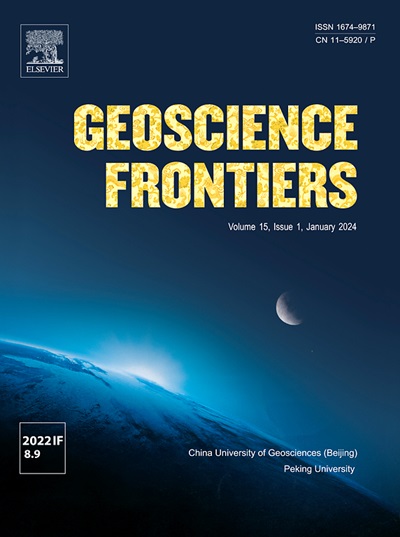Middle Cambrian convergence at the southwestern Baltica margin, Holy Cross Mts., Poland, and its significance for reconstructions of early Gondwana
IF 8.9
1区 地球科学
Q1 GEOSCIENCES, MULTIDISCIPLINARY
引用次数: 0
Abstract
The western periphery of Baltica has traditionally been viewed as a passive continental margin formed during the fragmentation of Rodinia and the opening of the Iapetus and Tornquist Oceans. This view is supported by the Volyn Large Igneous Province (VLIP) of Ediacaran age in Eastern Europe, which may be associated with break-up and evolution of the Tornquist Ocean. However, in western Ukraine, the sedimentary succession overlying the VLIP contains latest Ediacaran to early Cambrian detrital zircon with mixed εHf(t) values that can be interpreted to reflect deposition in a convergent margin setting with input from a continental volcanic arc. To investigate the potential convergent tectonic setting along SW Baltica during the Ediacaran to Cambrian transition, we conducted research in the Holy Cross Mts. (HCM), Poland. Here, tightly folded, and low-grade metamorphosed slates are unconformably overlain by Lower Ordovician (Tremadocian) sedimentary rocks. We applied 40Ar/39Ar geochronology on white mica defining cleavage in lower Cambrian rocks and U-Pb geochronology on detrital zircons to constrain the timing of the deformation. Our samples show similar populations of detrital zircons, with affinities to regions within or on the outskirts of Baltica. For all Cambrian samples, the calculated maximum depositional age is close to their stratigraphic age, suggesting rapid deposition in an active tectonic setting. The εHf(t) values range from −18 to +12, indicating significant mixing of mantle-derived magmas with mature crustal material typical of continental magmatic arc systems. Single-grain fusion 40Ar/39Ar geochronology on white mica yielded two populations of weighted average ages of 537 ± 1 Ma and 510 ± 4.4 Ma, interpreted as a detrital white mica population and the maximum approximation of the age of post-depositional early to middle Cambrian deformation, respectively. The similarities in zircon populations and isotopic compositions between Cambrian sediments of the HCM and those from Ukraine, suggest that both areas were sourced from a continental arc on the Baltica margin, above a subduction zone consuming Neoproterozoic Mirovoi Ocean crust. This arc is likely an equivalent to the Cadomian Arc on the opposite side of the ocean.

波兰圣十字山波罗的海西南缘中寒武纪辐合及其对早期冈瓦纳重建的意义
传统上,波罗的海的西部边缘被视为被动的大陆边缘,形成于罗丁尼亚分裂和伊阿佩特斯海和托恩奎斯特海的开放期间。这一观点得到了东欧埃迪卡拉纪Volyn大火成岩省(VLIP)的支持,它可能与Tornquist洋的分裂和演化有关。然而,在乌克兰西部,覆盖在VLIP上的沉积序列包含晚埃迪卡拉纪至早寒武世的碎屑锆石,其εHf(t)值混合,可以解释为沉积在大陆火山弧输入的辐合边缘环境中。为了探讨埃迪卡拉纪-寒武纪过渡时期波罗的海西南部可能的会聚构造环境,我们在波兰圣十字山(HCM)进行了研究。下奥陶统(特雷马多纪)沉积岩不整合地覆盖着紧密褶皱的低品位变质板岩。应用40Ar/39Ar年代学研究下寒武统白云母解理,应用U-Pb年代学研究碎屑锆石解理。我们的样品显示出相似的碎屑锆石种群,与波罗的海内部或外围地区有密切关系。所有寒武纪样品的最大沉积年龄均接近其地层年龄,表明寒武纪样品在活跃的构造环境下快速沉积。εHf(t)值在−18 ~ +12之间,表明幔源岩浆与大陆岩浆弧系统的成熟地壳物质存在明显混合。白云母单粒融合40Ar/39Ar年代学结果显示,加权平均年龄分别为537±1 Ma和510±4.4 Ma,分别为碎屑白云母种群和沉积后早-中寒武世变形年龄的最大近似。HCM的寒武纪沉积物与乌克兰的寒武纪沉积物锆石种群和同位素组成的相似性表明,这两个地区都来自波罗的海边缘的大陆弧,位于吞噬新元古代Mirovoi洋壳的俯冲带之上。这个弧线很可能相当于大洋另一边的卡多米安弧线。
本文章由计算机程序翻译,如有差异,请以英文原文为准。
求助全文
约1分钟内获得全文
求助全文
来源期刊

Geoscience frontiers
Earth and Planetary Sciences-General Earth and Planetary Sciences
CiteScore
17.80
自引率
3.40%
发文量
147
审稿时长
35 days
期刊介绍:
Geoscience Frontiers (GSF) is the Journal of China University of Geosciences (Beijing) and Peking University. It publishes peer-reviewed research articles and reviews in interdisciplinary fields of Earth and Planetary Sciences. GSF covers various research areas including petrology and geochemistry, lithospheric architecture and mantle dynamics, global tectonics, economic geology and fuel exploration, geophysics, stratigraphy and paleontology, environmental and engineering geology, astrogeology, and the nexus of resources-energy-emissions-climate under Sustainable Development Goals. The journal aims to bridge innovative, provocative, and challenging concepts and models in these fields, providing insights on correlations and evolution.
 求助内容:
求助内容: 应助结果提醒方式:
应助结果提醒方式:


